Log in or create new account to save this product to your wishlist.

How to Grow and Care for Blueberries in Your Garden
Home-grown blueberries taste the best. That’s at least what everyone who successfully planted blueberries in their own garden says. Most blueberries you can find in the supermarket are either from Peru or grown in hydroponics. So it is not really a surprise that many store-bought blueberries taste watery. Therefore, it’s best to just grow your own blueberries. We tell you how to best go about it.
The UK imports mos of their blueberries from warm countries like Peru, Morocco, Chile and Spain. But actually, the berries don’t need to grow in warmer countries to taste absolutely delicious. The blueberry plant simply needs some love and care to produce flavourful blueberries. Find out how to plant a blueberry push, care for it, and enjoy the fruits of your labour. Let’s start by choosing the right kind of blueberry plant for your tastes.
- Blueberry profile
- Choosing the right blueberry varieties
- Preparing the soil for blueberries
- Step-by-step guide to planting blueberries
- Ongoing care and maintenance
- Special care for container-grown blueberry plants
- Pruning and harvesting blueberries
- Harvesting blueberries
- Troubleshooting common problems
- General care and maintenance
- Blueberry planting FAQs
- Ready to plant blueberries?

Blueberry profile
- Origin: Blueberry plants are native to North America, where they grow in various regions, from the eastern and southern United States to Canada and Alaska.
- Natural habitat: They thrive in forest understories and meadow edges, often in areas that are acidic and well-drained. Blueberries are adapted to environments ranging from cold boreal forests to temperate climates.
- Substrate: Blueberry plants prefer acidic soils, with a pH ranging from 4.5 to 5.5. The soil should be well-drained, rich in organic matter, and capable of retaining moisture.
- Water requirements: These plants need consistent moisture, especially as they establish and during fruit development. However, they do not tolerate waterlogged roots well, so good drainage is crucial.
- Colours: Blueberry flowers are typically white or pink, delicate, and bell-shaped. The fruit ranges from blue to purple-black when ripe.
- Flowering Time: Blueberries generally flower in the spring. The timing can vary depending on the local climate and the specific variety, with fruit ripening in summer to early fall.
- Size: Depending on the variety, blueberry plants can vary significantly in size. They can range from low-growing shrubs less than 1 foot tall to larger bushes that reach up to 12 feet in height. There are three main types of blueberries: highbush (the most common), lowbush (also known as wild), and rabbiteye.
Choosing the right blueberry varieties
The botanical name of blueberry bushes is Vaccinium, and they are plenty of species. When selecting the blueberry varieties for your garden, it’s essential to consider several factors that influence their growth and fruit production. After you picked the best kind for your needs, we will delve into
Pollination needs
Blueberry bushes require cross-pollination for optimal fruit production. To ensure your plants thrive, plant at least two different varieties. This enhances pollination and leads to better yields and larger, sweeter fruit.
Pick characteristics
Each variety comes with unique characteristics including size, taste, and specific chill requirements—the number of hours a plant needs exposure to cold temperatures to break dormancy and produce fruit. That’s why you need to consider how cold it will get in winter where you are at, before you can narrow your choices down.
Consider growth habits and space
Also consider the constraints of your space, be it your garden, balcony, veranda, community patch or other. Compact varieties are ideal for smaller spaces. Lowbush varieties only reach about 2 feet, but they take up more space horizontally. They don’t require much pruning. If you have a larger area available, you may consider highbush varieties. These can grow up to 12 feet and require annual pruning. Are you looking to plant blueberries in your holiday home in a warmer climate? Then you’ll want to consider growing rabbiteye blueberry bushes.
Disease resistance and maintenance
Select varieties that are resistant to common diseases in your area. Some blueberries have been selectively bred to resist certain diseases, making them easier to maintain.
Preparing the soil for blueberries
As soon as you picked the right variety, you can get started by preparing the soil for the arrival of your new blueberry plant. First, test the soil’s pH. The ideal range for blueberries is between 4,5 and 5,5, so slightly acidic. If your soil is not within the desired pH range, amend it using sulphur or a specialised soil acidifier. Elemental sulphur is effective but requires time to adjust the soil’s pH, usually several months to a year. For quicker results, consider using ammonium sulfate, though be cautious as it can lead to plant burn if not used correctly.
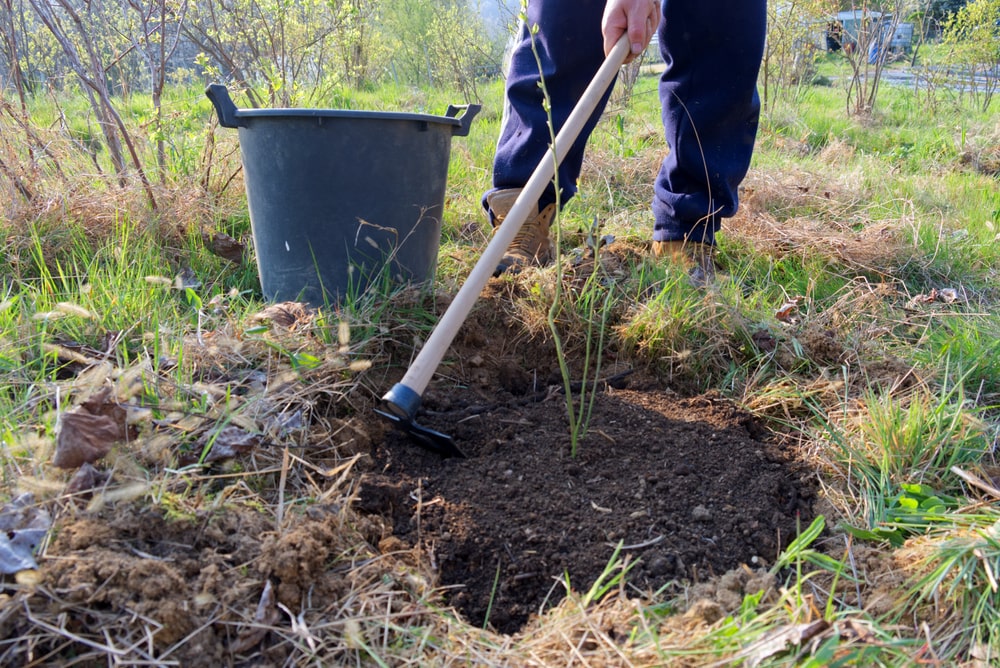
Incorporate a mix of organic materials such as peat moss, which has a naturally low pH, and well-aged compost to improve soil structure and fertility. Avoid materials with high nitrogen content like mushroom compost or fresh manure as they can raise the soil pH and are not suitable for blueberries.
Blueberries require well-draining soil to prevent root rot. If your garden area is prone to water-logging, consider raising the beds or planting in mounds to improve drainage.
Step-by-step guide to planting blueberries
The right variety is picked, the soil has the appropriate pH and the garden equipment is at the ready? Then you may follow this step-by-step guide to plant your blueberry bush in your garden.
- Choose the correct time
Plant your blueberries during the cooler months of autumn or early spring. Avoid planting in extreme weather conditions—too hot or frozen grounds could hinder root establishment.
- Pick the best spot
Opt for a sunny location as blueberries love the sun but can tolerate partial shade. Space your plants 3 to 5 feet apart to allow ample growth room and air circulation, which are crucial for healthy development.
- Get digging
Plant your blueberries at the same depth they were grown in their previous container, ensuring the root ball is level with the soil surface. This helps prevent root suffocation and promotes better root spread.
- Apply mulch
After planting, apply a thick layer of organic mulch like pine bark or leaf mould around the base of each plant, leaving a small gap around the stem to prevent rot. This mulch will help maintain soil acidity and moisture.
- Water your blueberries
Initially, water your plants generously to settle the soil around the roots and then use rainwater for irrigation, as it is more acidic than tap water, helping to maintain the necessary soil pH levels.
- Protect against birds
Since birds find blueberries quite tempting, it’s wise to protect your bushes with netting or a fruit cage, especially as the fruit begins to ripen.
Ongoing care and maintenance
As soon as your blueberry bush is planted, it needs to be looked after now and then.
Watering requirements
Ensure blueberry plants are kept moist throughout the growing season. Regular watering is crucial, especially during dry spells. Preferably use rainwater for irrigation as it helps maintain the acidic conditions blueberries thrive in.
Feeding and mulching
Feed ground-planted blueberries with a high nitrogen feed in late winter. For container-grown plants, use a liquid fertiliser for ericaceous plants monthly. Apply a 3-inch layer of acidic organic matter such as pine needles or leaf mould each spring or autumn to preserve soil moisture and acidity.
Protection strategies
Wrap containerised plants in hessian or bubble wrap during severe cold. Use horticultural fleece for young plants in harsh conditions. Protect ripening berries from birds with netting or a fruit cage, and encourage beneficial insects like ladybugs to manage aphids.
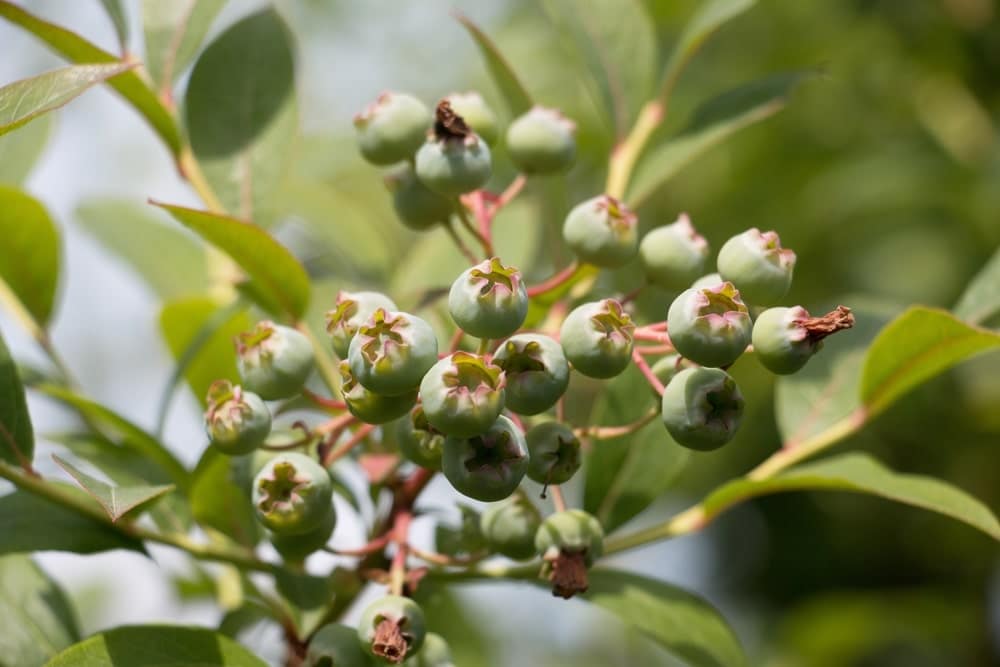
Special care for container-grown blueberry plants
Blueberry plant care for container grown bushes requires some extra effort. Move plants to larger pots when roots appear through the drainage holes to encourage continued growth. Container plants require diligent watering, particularly in terracotta pots, which may dry out faster. Also, they need to be fertilised frequently—no exceptions.
Pruning and harvesting blueberries
Pruning helps your blueberries to stay healthy and produce more and tastier berries. And of course, harvesting in the best (or tastiest) part.
Pruning Blueberries
- Timing: Prune your blueberries in late winter or early spring, ideally between November and March when the plants are dormant. This helps prepare them for vigorous spring growth.
- Technique: Focus on removing dead or damaged branches, diseased wood, and one or two of the oldest canes each year to promote healthy new growth. Cut back twiggy wood at the end of branches to an upward-facing bud or the nearest branch.
- Rejuvenation: For mature, overgrown plants, conduct a careful renewal pruning by removing about half of the branches back to the ground. This encourages younger, more productive branches to develop.
- Maintenance: Maintain a balance in the bush’s structure, aiming for about one-third young shoots, one-third prime growth, and a third older growth. Avoid shearing blueberries into a meatball shape and use clean, sharp pruning equipment.
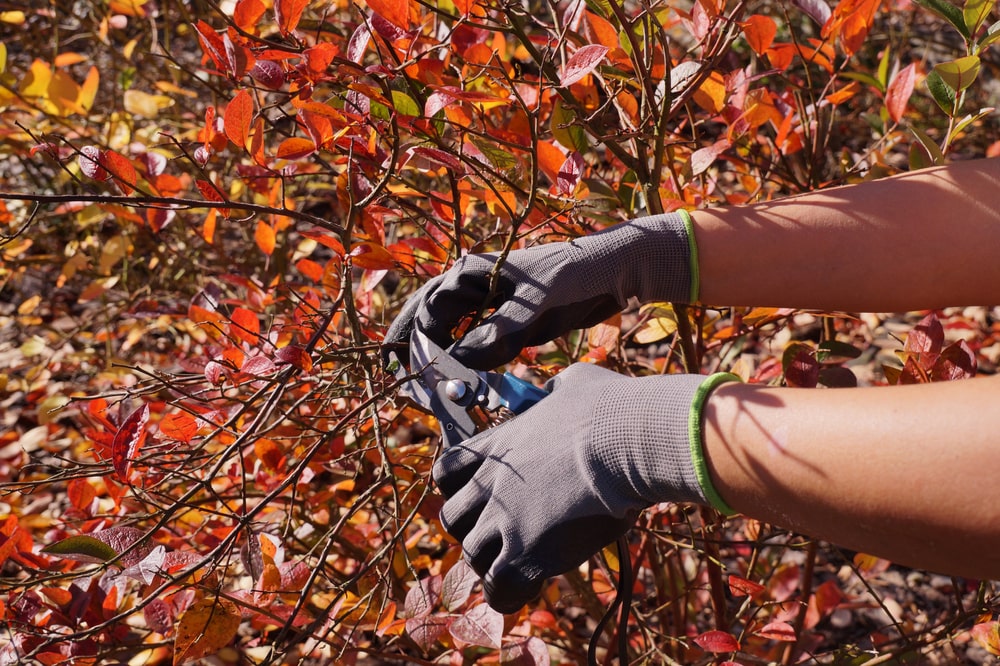
Harvesting blueberries
- Ripeness indicator: Blueberries are ready to harvest when they turn a deep blue colour and detach easily from the cluster. For the best flavour, leave them on the bush for a few more days after they turn blue.
- Picking period: Since blueberries ripen at different times, regular picking is necessary throughout the ripening period, which typically starts from mid-summer.
- Technique: Gently pick the ripe blueberries by hand to avoid damaging the plant. Ensure that the berries come off the bush easily and check for a sweet, tangy flavour to confirm ripeness.
Troubleshooting common problems
Are you worrying something is wrong with your blueberry plants? Most of the problems you might encounter were already thoroughly analysed and solved. Here are the most common issues when growing blueberries and their solutions.
Leggy plants, no flowers or fruit
Blueberries demand several hours of full sun daily to flourish. If your blueberry plants are leggy with no flowers or fruit, it might be due to insufficient sunlight. So make sure, they are planted in the sunniest parts of your garden. Alternatively, if fixed planting isn’t viable, consider using containers for your blueberry plants, which you can move to catch the most sun.
Stunted plants, dying foliage
Blueberries require consistently moist soil to avoid stunted growth or dying foliage. Especially during hot, dry periods, consistent moisture is key. Setting up an irrigation system can help maintain this crucial moisture balance, ensuring your blueberries stay healthy and vibrant.
Disease and pest management
- Blueberry leaf scorch and shock virus: These diseases can cause significant damage to your plants. For leaf scorch, remove and burn affected plants and maintain an aphid-free garden to prevent its spread. For shock virus, most plants will develop immunity over time, but initial symptoms can be distressing.
- Stem canker: This fungal disease causes brown blotches on stems and leaves. Prune affected areas thoroughly and dispose of the removed parts. Always sterilise your tools after cutting diseased plants to prevent further spread.
General care and maintenance
Use unfertilised peat or rhododendron soil, which suits the shallow roots of blueberries, rather than regular garden soil. This helps maintain the necessary acidity and moisture levels. Birds are fond of blueberries; protect your harvest with netting or a fruit cage to ensure you get to enjoy the fruits of your labour.
Blueberry planting FAQs
To propagate blueberries effectively, start by selecting a healthy growth early in the morning. Prepare the cuttings by retaining only the top few leaves and making a cut just above a leaf node at the bottom. Dip the cuttings into rooting powder and place them into a free-draining soil mix. Water the soil after planting the cuttings.
Blueberries thrive best in acidic soils with a pH range of 4.5 to 5.5. It’s important to test your soil’s pH level before planting and adjust it to meet these acidic conditions if necessary. This can often be done by incorporating sulphur or other acidifying agents into the soil.
Blueberries grow best in areas that offer full sunlight and well-drained, acidic soil with a pH between 4.5 and 5.5. They thrive in temperate to cold climates and can be very successful in regions with clear seasons, particularly enjoying the chill in winter for bud development.
Yes, blueberries can grow in the UK. They are well-suited to the British climate, especially when planted in a sunny position and in acidic, well-draining soil or nutrient-rich compost if in pots.
The best month to plant blueberries is in the late autumn or early spring when the plants are dormant. This timing allows the roots to establish in cool conditions before the growth season starts.
Ready to plant blueberries?
Plant your blueberries when the time is right, and you can look forward to a delicious blueberry harvesting in the summer. A fully grown plant can produce around 10 lbs of berries. In case you are interested in planting other tasty bushes, we have articles on strawberries and raspberries to offer. Fig trees also produce delicious fruit. If you have a question or maybe a blueberry planting tip for us, leave a comment.
Happy gardening!
-
Orchids: A Complete Guide on How to Care for ThemWant to give your orchid the best possible care? Discover essential tips from placement to watering and pruning. Learn everything you need to know!Read more
-
Growing Wisteria Made Simple: From Planting to Perfect BloomsWith blossoms like a purple waterfall, Wisteria sets an almost magical and colourful mood. If you want to grow this beauty in your garden, you’ll need a bit of patience. Don’t worry, it will most definitely pay off.Read more
-
How to Build a DIY Greenhouse: A Practical Guide for Smart SpendersImagine extending your growing season throughout the year, nurturing tender plants regardless of the weather, and creating a personal garden sanctuary. This is precisely what a DIY greenhouse offers you. Let’s learn how to build one.Read more
-
How to Grow Eucalyptus in British GardensWith a little love and care, eucalyptus trees can thrive in English gardens. Since they don’t germinate well without proper help, there are not considered invasive. So, there is no reason not to plant them if you enjoy their looks.Read more
-
Transform Your Garden with All-Year-Round Flowering PlantsDid you know you can enjoy blooming flowers even in January? With the right selection of all year round plants, there’s no need to wait until spring to add some colour to your garden.Read more
-
How to Create a Butterfly Garden: A Simple Guide for British GardensThe UK's butterfly population includes 59 different species. These beautiful winged creatures face a steady decline because of habitat loss, pollution and changing weather patterns. Your garden can become a vital link between nature reserves and natural habitats. Let’s explore how.Read more
-
Volcanic Rock Dust for Your Garden—Application and TipsDid you know that volcanic rock dust is a brilliant organic soil improver? This article explains exactly what it's good for and how to use it properly.Read more
-
How to Use Landscape Fabric ProperlyIf weeds or erosion in your garden are troubling you, landscape fabric might be the solution. We’ll explain how and when to use it properly, just keep on reading.Read more
Leave a comment
Your answer will be displayed on the site and the interested party will be notified by email.
Leave a comment
Have a question or want to share your experience? Leave us a comment.

- Order by 2PM = shipped today
- 250.000+ satisfied customers!
- 60 day satisfaction guarantee

- Order by 2PM = shipped today
- 250.000+ satisfied customers!
- 60 day satisfaction guarantee

🌱 All important maintenance moments for your lawn during the year. Leave your email and we will send you the lawn calendar for free.
Enter your email
Receive the lawn calendar in the mail
Enjoy a green lawn all year round!















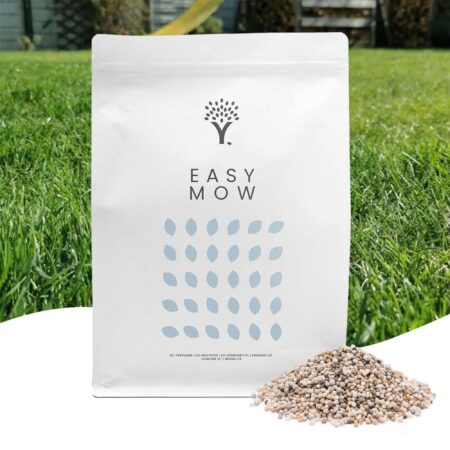
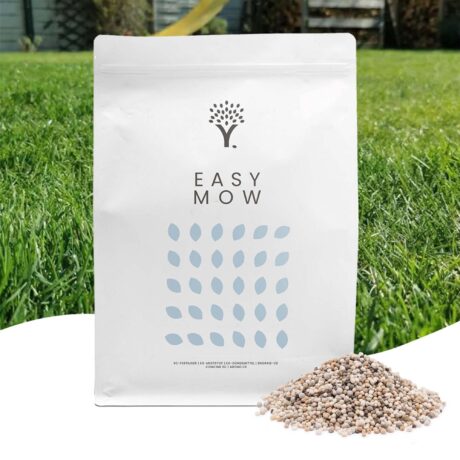





Comments (0)
There are no comments yet. Well then, what are you waiting for to
Be the first to write your comment!inaugurate this pretty page?
Do you have some comments?